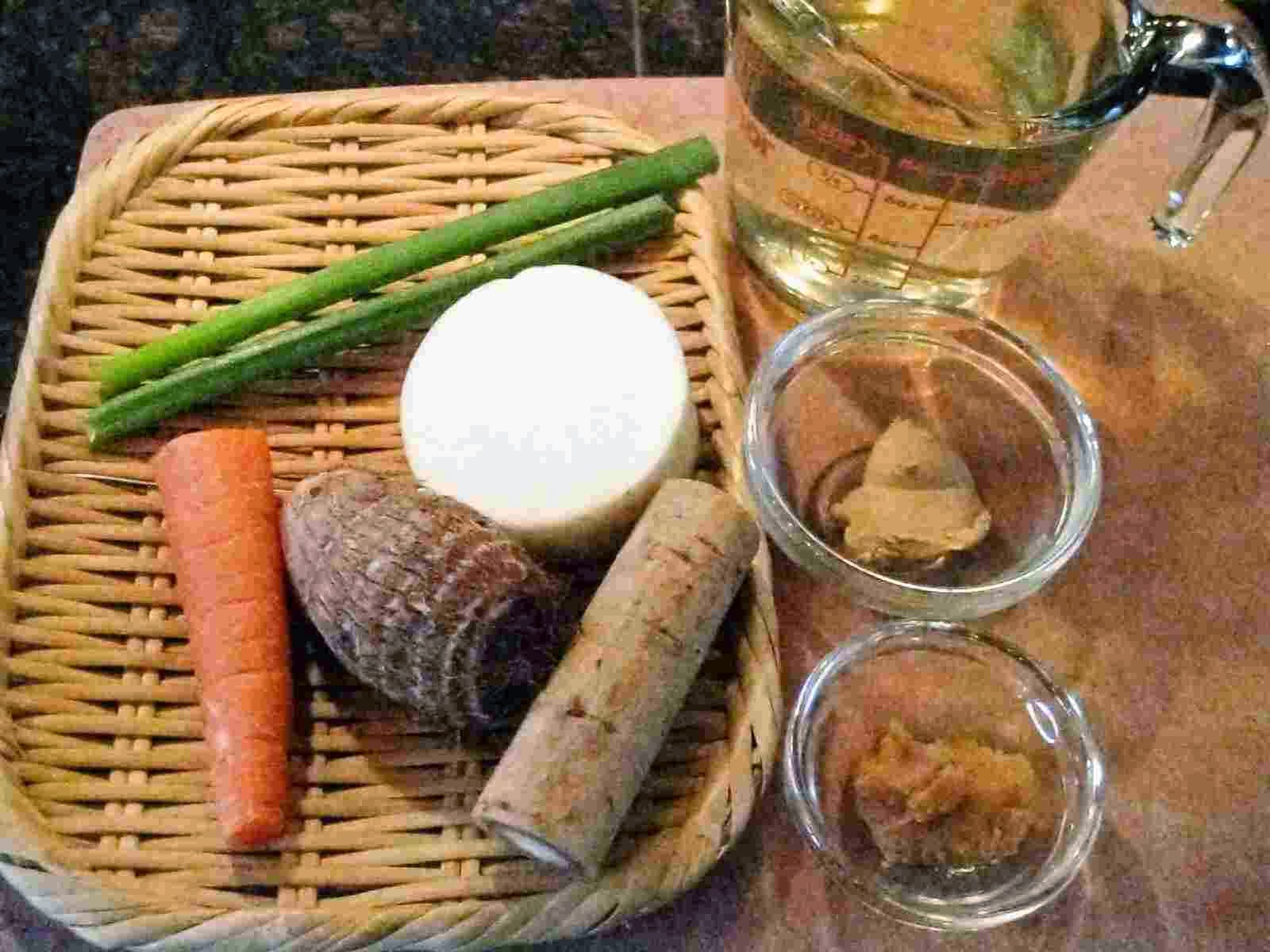Hearty, satisfying and warming – and all you have to do is add sakekasu to your everyday miso soup. Aromatic and flavorful, sakekasu also lets you use even less miso than my recent low-sodium recipe for miso soup with yogurt.
1/2 of recipe:
50 calories; 2.3 g protein; 0.4 g fat; 9.0 g carbohydrate; 6.4 g net carbs; 189 mg sodium (with reduced-sodium miso; 234 mg with regular miso); 0 mg cholesterol; 2.6 g fiber
<Ingredients>
1/2 small carrot (24 g in photo)
2-3 cm daikon radish (58 g in photo)
7-8 cm gobo burdock root (35 g in photo)
1 satoimo baby taro root (52 g in photo9
1 green onion (green section)
250 cc dashi
1 tsp sakekasu sake lees
1 1/2 tsp miso
<Directions>
1.
Rangiri diagonally cut gobo, daikon, carrot and satoimo.
Soak gobo in water.
Thinly slice green onion.
2.
In a small pot, put dashi, gobo, daikon, carrot and satoimo.
Cover, and simmer on low heat until vegetables are nearly soft.
3.
Meanwhile, take some dashi from pot, and loosen sakekasu and miso.
4.
Add sakekasu, mix, cover, and continue to simmer until vegetables are tender.
5.
Add miso, mix well, and heat broth almost to boiling.
6.
Serve in individual bowls, and garnish with green onion.
<Notes>
1/2 of recipe:
50 calories; 2.3 g protein; 0.4 g fat; 9.0 g carbohydrate; 6.4 g net carbs; 189 mg sodium (with reduced-sodium miso; 234 mg with regular miso); 0 mg cholesterol; 2.6 g fiber
<Ingredients>
2-3 cm daikon radish (58 g in photo)
7-8 cm gobo burdock root (35 g in photo)
1 satoimo baby taro root (52 g in photo9
1 green onion (green section)
250 cc dashi
1 tsp sakekasu sake lees
1 1/2 tsp miso
<Directions>
1.
Rangiri diagonally cut gobo, daikon, carrot and satoimo.
Soak gobo in water.
Thinly slice green onion.
2.
In a small pot, put dashi, gobo, daikon, carrot and satoimo.
Cover, and simmer on low heat until vegetables are nearly soft.
3.
Meanwhile, take some dashi from pot, and loosen sakekasu and miso.
4.
Add sakekasu, mix, cover, and continue to simmer until vegetables are tender.
5.
Add miso, mix well, and heat broth almost to boiling.
6.
Serve in individual bowls, and garnish with green onion.
<Notes>
- Sakekasu is easier to loosen with warm liquid (water, dashi, etc.). If using pressed-type sakekasu, add water or dashi early on in order to give it enough time to loosen up.
- Sakekasu does contain a relatively high amount of alcohol. Make sure to simmer at least 10 minutes after adding it to soup. As it lets off alcohol, the soup becomes mellow with substantial depth.
- Make sure to cover the pot while simmering vegetables so that all moisture is retained. If you don't use a lid, you could add more dashi to make up for the portion that evaporates, but more dashi means more sodium. And if you add water, the broth becomes a bit watery.
- Also watch the heat level when simmering vegetables -- satoimo is famous for creating foam and making the broth overflow when cooked on higher heat. When it is gently simmered on low heat, it usually behaves well and bubbles will not escape the pot even when covered.
- Once you get used to a low-sodium diet, 1 tsp sakekasu and 1 1/3 tsp or 1 1/4 tsp miso should be satisfactory. To me, the combination of 1 1/2 tsp miso and 1 tsp sakekasu above provides more of a salty sensation than the combination of 2 tsp miso and 1/2 tsp yogurt I use in regular miso soup these days.









No comments:
Post a Comment